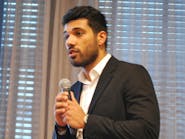Egypt’s ERC builds a digital refinery for the future
In the Greater Cairo area of Egypt, the Egyptian Refining Company (ERC) is redefining the way oil and gas refineries can think about their control systems. When its $4.3 billion greenfield oil refinery came online in 2019, it was configured to manufacture environmentally friendly products as well as satisfying the growing demand for energy in the Egyptian market. While its 4.7 million tons of refined product per annum is impressive, its development as a digitalized, cybersecure and automation-ready journey has been even more so.
At Honeywell Users Group EMEA in The Hague, Netherlands, on March 12, ERC executives Tarek Ghaleb, the company’s senior digitalization and process control expert, and AbdelRahman Munsif (pictured), lead for process control, automation and industrial digital transformation, discussed the company’s journey. They outlined the challenges of digitalization, moving beyond automation to autonomous operations, building cybersecurity in lockstep with the greenfield build up, and a future incorporating artificial intelligence (AI).
As one might expect judging from the timeline, the early years of the project were wrought with challenges, not the least of which was the 2020 COVID-19 pandemic that caused more than a few changes in direction.
“Our digital transformation journey was affected because of many reasons,” Munsif said. “One of them was when the pandemic was widely affecting global economics, and our supply chain.”
But in some ways, the experience only strengthened the overall commitment to make workflow more automated to minimize human errors and the optimize maintenance activities at the plant.
Why digitalize?
While ERC had several advantages in mind for the future when it decided to build a digital facility, three main areas stood out. First, they wanted to realize a 20% cut in operation costs. they accomplished their first goal through digitalization of energy, assets and operations management, as well optimizing flaring activities.
They also planned a roadmap for sustainability, which includes carbon capture and reduction, greenhouse gas management, water conservation and waste monitoring, to name a few methods. In addition, they wanted to maximize yield and margins. To accomplish this, they digitalized control loops and instituted advanced process control and alarm management.
“At first we only got a million alarms per day and they were meaningless,” admitted Ghaleb. But eventually, they got it right and their now robust alarm management system keeps operations running smoothly.
Ghaleb said the company is currently evaluating the benefits gained from investing in advanced OT solutions overall, including real-time optimization and operator competency management. He expects each aspect of the digital journey to continue to evolve.
Automation to autonomy
ERC was not only focused on current automation of its operations but ultimately autonomy. With the help of Honeywell Process Solutions, ERC mapped out a plan to mature its level of autonomy. It began with manual and semi-manual operations and proceeded through advanced control of its operations to establishing intelligent operations onsite. From there, the levels advance through remote and adaptive operations and ultimately autonomous operations.
Key enabling technology for the transition includes smart sensors and IIoT, AI and machine learning, digital twins and simulation, edge computing and integration of process control and enterprise resource planning (ERP) systems per ISA-95.
They also upgraded their DCS from Experion R430 to Experion R530 while overcoming bottlenecks in the phase out of R430. ERC and Honeywell conducted on-process migration (OPM) in a very critical shutdown window so there was minimal impact on operations. Ghaleb attributes their successful OPM to a successful FAT.
In addition, they relied on hardware installations with longer life cycles, the latest Experion releases, and a more secure network.
Cybersecurity from the ground up
Munsif said that one of the main lessons they learned from the project is that cybersecurity is better when build from the start along with the network. Again, with the help of Honeywell cyber solutions, ERC adopted an industrial cybersecurity framework for benchmarking and guidance for OT based on IEC 62443.
Cyber enhancements became mandatory for ERC for IT-to-OT integration, and they were sure to eliminate the gaps in the networking that might allow targeted attacks.
Evolving digital vision
Ghaleb said ERC’s focus for 2026 is an AI/ML-driven solution for process optimization. “We still believe that there is always a performance for optimization, small tuning that will leave significant benefits,” he said.
Alarm and events prediction continues to be a focus as a potential methodology to avoid process upsets before they take place. He knows, however, that it won’t be sufficient unless there are provisions for fast action that seamlessly appear on the operator DCS graphics pre-empting low-priority events. To help, they’re turning to Honeywell’s HALO, which uses AI to analyze plant data to improve operator performance, and similar solutions.
Another area of exploration, Musif said, is the establishment of an immersive field simulator (IFS). “We are studying the feasibility and need for integrating existing OTS models with an IFS solution to enable the field operator to get the exact feels-like of plant plot plan, layout, and equipment locations.”
ERC is also planning an upcoming maintenance turnaround in 2029. It plans to convert the plant’s control systems into a fully virtualized DCS infrastructure. The benefits, they say include reduced hardware and operating system changes, ease of maintenance, improved reliability, and an accelerated project schedule, to name a few.
It will be the culmination of a decade of planning that will ultimately turn ERC into a fully digital facility.

